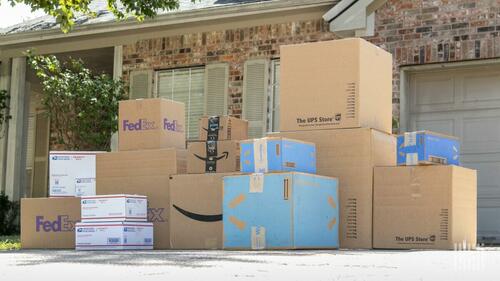
FedEx And UPS Must Adapt To Changing Parcel Landscape
By Satish Jindel, president of ShipMatrix Inc., a consultancy, and founding member of RPS (now FedEx Ground) who has analyzed trends in the parcel and less-than-truckload sectors for 30 years. Via FreightWaves
For decades, FedEx and UPS essentially functioned as a duopoly in the U.S. parcel delivery market. With few challengers, they made lots of money.
 FedEx and UPS face strong headwinds from Amazon, Walmart and other delivery companies as B2C delivery overtakes the B2B market they were built to serve. (Photo: Jim Allen/FreightWaves)
FedEx and UPS face strong headwinds from Amazon, Walmart and other delivery companies as B2C delivery overtakes the B2B market they were built to serve. (Photo: Jim Allen/FreightWaves) The second-quarter earnings release from UPS on July 23 shocked many investors, resulting in the stock dropping 12% within minutes of the earnings call. The big surprise was that UPS customers are downgrading from Air Express to Ground service and from Ground to the lower-priced SurePost, an economy service that involves injecting parcels into the U.S. Postal Service system for final-mile delivery.
If the market was paying attention to what the carriers were saying in prior earnings calls, they should have expected these changes. Both FedEx and UPS in recent years have touted how their improved Ground service made transit times faster than those of their competitors. In the process, they also created a competitor to their own Express and Deferred services.
Since 2019, UPS has expedited Ground transit times to the point that delivery time has fallen from three days to two days for 12% of lanes and from three days to two days for an additional 22% of its routes, allowing more express and deferred parcels to be converted to ground. Even SurePost, which takes one to two days longer than Ground service for delivery, has experienced transit time improvements for 7% of packages, prompting customers to downgrade service options.
The decline of Express and Deferred volumes actually started more than two decades ago. It began when FedEx acquired RPS (rebranded as FedEx Ground) and the industry guaranteed day-definite ground service. In 2000, the FedEx Express operating unit handled 2.92 million parcels per day. Throughput for fiscal year 2024, ended May 31, was 2.58 million parcels. During the same period, FedEx Ground daily volume has increased from 1.52 million to 10.7 million parcels.
Furthermore, with investment in multicarrier manifesting systems from companies like ProShip, and visibility and analytics from companies like ShipMatrix, shippers are now able to utilize cheaper and yet faster ground services.
A major inflection point has been the explosive growth of e-commerce over the past 10 years, which has resulted in 65% of all domestic parcels being delivered directly to consumers. And, with more online orders now fulfilled from local stores or by Chinese retailers like Temu and Shein bringing orders into gateway airports like Miami, Los Angeles, Dallas and Chicago, the last-mile deliveries are being done by smaller companies like Better Trucks, Jitsu, Veho, Uni-Uni and SpeedX, which operate with a lower cost structure.
And, while these regional carriers may eventually lose the business to FedEx and UPS, the heightened regional competition forces the giants to operate in shorter shipping zones that have lower margins, resulting in lower yields per parcel.
Equally important is the growth of private fleets by major retailers. Amazon delivering over 22 million parcels per day using drivers employed by its network of delivery service partners. Walmart is doing something similar.
“In Walmart U.S., over the last 12 months, 4.4 billion items were delivered the same or next day, with about 20% of those delivered within three hours,” Walmart CEO Doug McMillon stated on the company’s May 16 earnings call.
That means Walmart delivers over 4 million parcels per day from its 4,600 local stores by deploying alternate approaches, including the use of gig workers at companies like Uber Eats and DoorDash typically known for food delivery.
With the push over the past decade to fulfill online orders from facilities closer to the consumer, the percentage of parcels traveling shorter distances (less than 300 miles) has increased from 45% to 68% while those going 1,400 miles or more have shrunk from 17% to 10%.
The shift of large e-commerce retailers from Ground to SurePost and UPS’ rollout of a cheaper Ground Saver service with transit time of Ground plus three days illustrates that consumers will accept slower delivery for a lower price of the item. Even Amazon, which has pushed the envelope on faster delivery, is responding to low-cost competition from Temu and Shein.
Amazon recently announced it will offer a discount marketplace for lower-priced items that are shipped from overseas directly to consumers within 10 days of an order by avoiding stocking at more expensive U.S. fulfillment centers.
Given these monumental developments, by the 2026 peak season the private fleets of major retailers and local companies are positioned to deliver more parcels to residences than FedEx and UPS combined. We’re talking about more than 40 million parcels per day. FedEx and UPS leaders need to prepare for that future.
Tyler Durden
Tue, 08/06/2024 – 14:20















